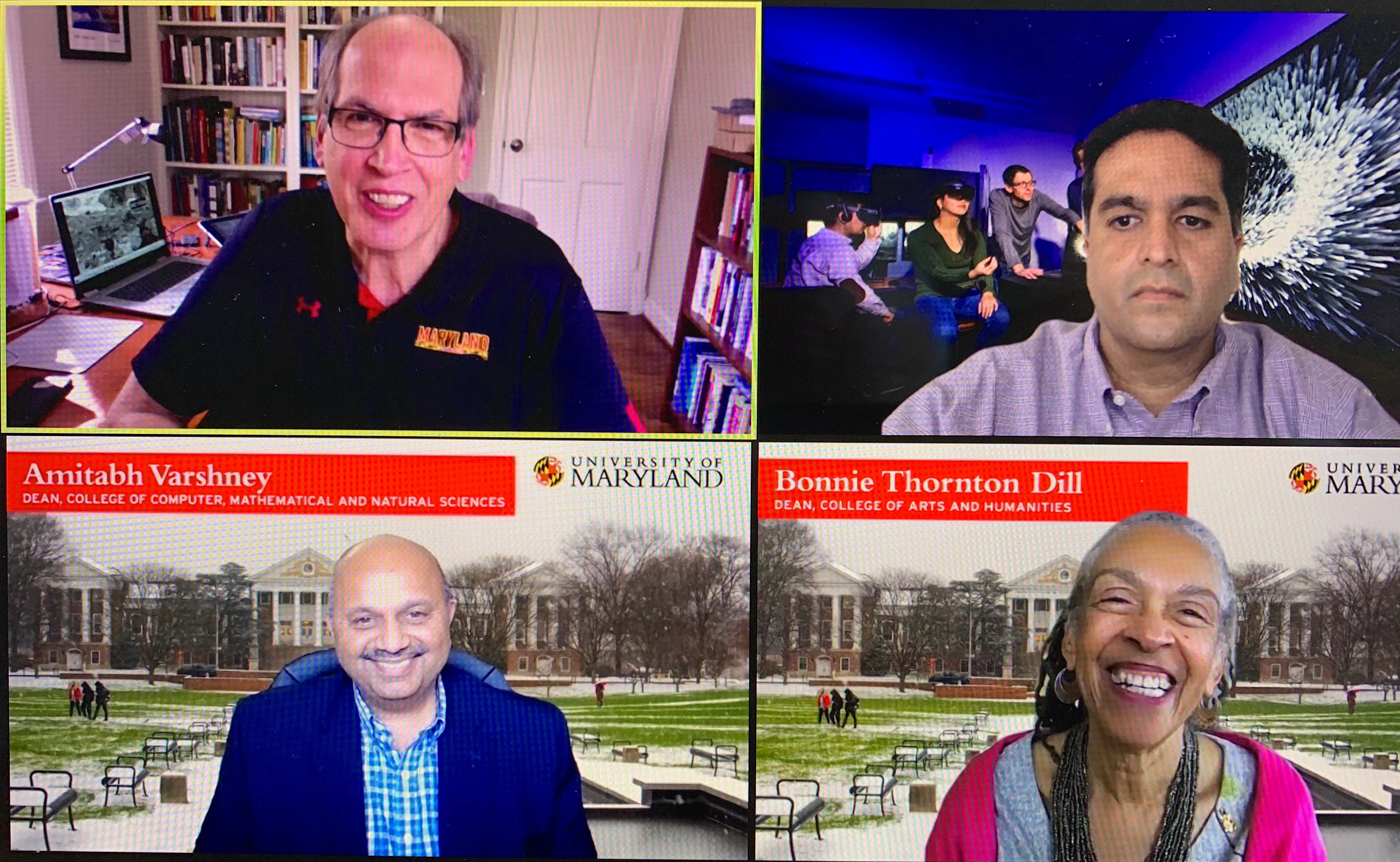
Faculty, staff and students from nine departments and six colleges recently came together for a virtual workshop to showcase all-things-immersive at the University of Maryland.
Hosted by the university’s Immersive Media Design (IMD) program and the Mixed/Augmented/Virtual Reality Innovation Center (MAVRIC), the Feb. 26 workshop was designed to stimulate conversations and open new pathways for increasing collaboration and support of all-things-immersive across the UMD campus. (A full recording of the four-hour workshop is available here.)
“It was inspiring to see how researchers from computer science and art—as well as other disciplines from across the campus—are incorporating immersive media technologies into their work,” said Roger Eastman, a professor of the practice in computer science who is the director of IMD. “This represents the breadth and depth of expertise, resources and opportunities that incoming IMD students will have access to.”
Opening remarks for the workshop came from Bonnie Thornton Dill, professor and dean of the College of Arts and Humanities, and Amitabh Varshney, professor and dean of the College of Computer, Mathematical, and Natural Sciences (CMNS).
“The arts and humanities provide skills, not just in the visual arts, but in narrative storytelling, empathy, ethics and social context—all of which are essential to the impactful use of immersive media,” Thornton Dill said in her remarks.
Varshney, who was instrumental in forming a university-wide committee in 2016 that led to the establishment of the IMD program, echoed those comments.
“Immersive media has the potential to make our lives and relationships so much more meaningful and impactful, and our IMD graduates will be the ones driving the field forward,” he said.
The keynote talk was presented by Marc Ruppel, a UMD alumnus with a Ph.D. in English, who is currently a senior program officer at the National Endowment for the Humanities. Ruppel gave a detailed overview of federal funding opportunities for projects and activities that rely on immersive media for education, storytelling, artistic impressions, or technical innovations.
“We want impactful projects, but also projects that people can use,” Ruppel said in his address.
Other highlights from the workshop included a lightning talk from Matthias Zwicker, professor of computer science and interim chair of the Department of Computer Science. Zwicker, who is a lead faculty member in the IMD program, outlined recent advancements in computer graphics rendering algorithms that are bringing us closer to achieving movie-quality rendering in interactive virtual reality applications.
Another presenter was Mollye Bendell, a studio arts lecturer and the first faculty member to teach an IMD course at UMD last fall. As an artist, Bendell explores longing and visibility in ephemeral media. She presented Sketch for Sleepers, an attempt to preserve people through digital masks molded around images from video chats. Bendell said she began the piece during the COVID-19 quarantine around her fear that the last time she might see her loved ones would be on a video call.
Immersive technologies used in health care, medical training and the performing arts were showcased by researchers from the Maryland Blended Reality Center (MBRC), a multi-institutional effort between UMD and the University of Maryland, Baltimore, that is co-directed by CMNS dean Varshney.
The MBRC team discussed how they are imagining new ways of engaging audiences with musical performances, including opera and solo violin; developing immersive platforms to improve severe weather forecasting; building anatomy training modules in virtual and augmented reality that can be used by medical students; prototyping an immersive point-of-care ultrasound diagnostic imaging unit; creating scalable work training modulesusing mixed reality; and building a multiple camera array studio to produce cinematic holograms.
###
About IMD: The immersive media design major prepares students to excel in creativity and innovation using the latest digital tools and technologies. It is the first undergraduate program in the country that blends art with computer science to encompass a wide range of immersive media applications. The major represents a unique collaboration between the College of Arts and Humanities and the College of Computer, Mathematical, and Natural Sciences. IMD receives technical and administrative support from the University of Maryland Institute for Advanced Computer Studies.
About MAVRIC: MAVRIC connects the university’s world-class research expertise by faculty and students focused on immersive media—and its state-of-the-art facilities—with the assets of academic, public sector and corporate partners in Maryland, Washington, D.C., and Virginia. The center’s core mission is to foster the development of immersive media technologies by building a network of influencers and executive champions, supporting the participation of traditionally underrepresented groups, and providing the strategic support needed to build a successful technology cluster that is centered at the University of Maryland.